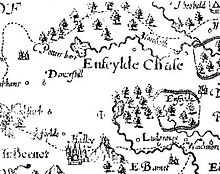Enfield Old Park

Early history
The Park was situated around the site of an Iron Age hill fort, the remains of which can still be seen in the vicinity of the building of Old Park House (now belonging to the Bush Hill Golf Club). These constitute the largest present-day hill fort remains in the old county of Middlesex.[1]
The Domesday Book (1086) records the Manor of Enfield as being held by Geoffrey de Mandeville and mentions 'there is a park there'. The word 'park' in this sense refers to a preserve for game, and the park was reserved for this use until the 18th century. As the manor of Enfield had been held in Anglo-Saxon times by Asgar, Master of the Stud to Edward the Confessor, it is very possible that the area was already a game-park before the Norman Conquest. John Norden's map of Middlesex (c. 1593) clearly shows the fenced-in Old Park, with Salmons Brook flowing through it.
Royal property
In the mediaeval era the Park was recorded in documents as 'Parcus Intrinsicus' (Latin, 'the Inner Park') to distinguish it from the much larger, and unenclosed, Enfield Chase. The name 'Old Park' seems to have been applied from the 15th century. Around this time, the Park, together with the Manor of Enfield, became royal property as part of the Duchy of Lancaster.
Queen Elizabeth I frequently visited Enfield for hunting and stayed sometimes at the Manor House, known as 'Enfield Palace',[2] which stood at the edge of the Park, and sometimes at Enfield House (Elsyng Palace). In 1596, Robert Carey, 1st Earl of Monmouth recorded that "The Queen came to dinner at Enfield House and had toils [traps] set up in the park to shoot the bucks after dinner".[3]
In the early 17th century the course of the New River was laid through part of the Park. In April 1620 a review of the Park's stock gave a total of 207 fallow deer, of which 73 were "Deare of Anteleir" (i.e. antlered males).[4]
During the Commonwealth period, the Park was sequestered by Oliver Cromwell's Protectorate, and a detailed survey was prepared. This assessed the area of the Park as 553 acres (2.2 km2), and its value as £311/10/- (i.e. £311.50 in present day notation). It also mentions the Park's stock of coneys (rabbits), and "50 sorts of several deer".[5] The Park was given initially to Parliamentary soldiers in lieu of their overdue wages, but was then granted to George Monck, 1st Duke of Albemarle.[6]
Enclosure and after

The advent of the railway to the area (both Grange Park station and Enfield Chase station are situated within the original boundaries of the Old Park) meant that the land became valuable for domestic housing, and between 1910 and 1936 most of the present suburb of Grange Park was constructed.
The Park is still remembered in several road names, notably Old Park Ridings, Old Park Road and Old Park Avenue. Enfield Town Park is however the only public remnant of the open space that was once Enfield Old Park.
Sources
- Haigh, Douglas, Old Park in the Manor of Enfield, London 1977.
- Pevsner, Nikolaus and Bridget Cherry The Buildings of England: London 4:North, London 1998 ISBN 0-14-071049-3
- Victoria Country History: Middlesex, vol.5, London 1976 (also online)
- Weinreb, Ben, The London Encyclopaedia. London, 1983
Notes
- ↑ Pevsner and Cherry, 1998 pp. 421-2
- ↑ Weinreb, 1983, p. 261
- ↑ Haigh, 1977, p. 38
- ↑ Haigh, 1977, p. 53
- ↑ Haigh, 1977, p. 50
- ↑ Victoria County History (Middlesex vol. 5)
- ↑ Victoria County History
Coordinates: 51°38′57″N 0°06′11″W / 51.6493°N 0.103°W